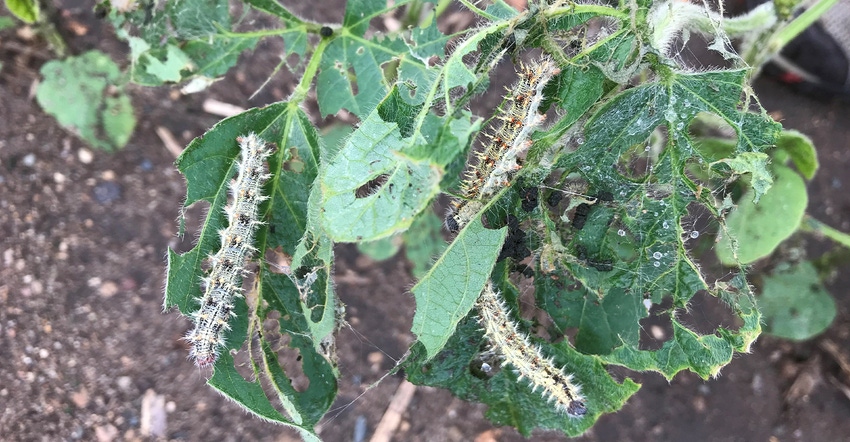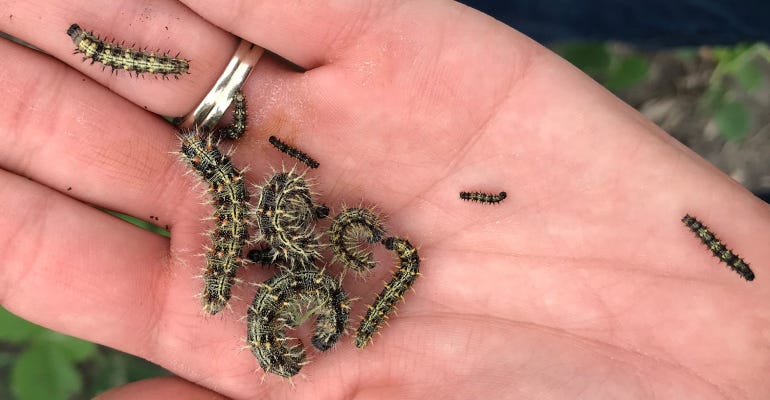August 27, 2019

Farmers have seen several soybean insects show up in fields this summer in Iowa. These pests include thistle caterpillars, soybean aphids and soybean gall midge.
Soybean fields have been invaded by unusually high populations of thistle caterpillars, which defoliate soybean leaves. It is recommended that soybean growers apply a foliar insecticide if damage exceeds 20% per plant after plants reach reproductive stage. If you have caterpillar feeding damage before bean plants are in reproductive growth stage, the treatment threshold is 30% defoliation per plant.
It takes quite a few thistle caterpillars to reach 20% feeding damage, but these are big caterpillars with a big appetite. As we learned this year, you need to keep an eye on the growth of the caterpillar population when they first show up on soybeans in a field. Defoliation has been severe in some places and required an insecticide application, while in other fields treatment has not been warranted.
Defoliators of soybeans
Thistle caterpillars mainly produce two generations per year, maybe three in some cases when weather favors it. This pest migrates into Iowa and other Midwest states as the butterfly adults fly up from Mexico each spring. The moths lay eggs in fields, which hatch to produce the larva (caterpillars) that chew on soybean leaves, devouring the leaf tissue.
Since this pest doesn’t overwinter here, it’s hard to predict how many will fly up from the south each spring. But we sure saw a lot of the butterflies (adult stage of caterpillars) in Iowa this year. Go online to find more information as well as photos to help identify thistle caterpillars.
 INVADERS: This field averaged more than one thistle caterpillar per plant and had a wide range of caterpillar sizes.
INVADERS: This field averaged more than one thistle caterpillar per plant and had a wide range of caterpillar sizes.

The second generation of this insect was completed by early to mid-August this year in Iowa. It remains to be seen whether or not a significant amount of egg laying will take place to produce a third generation of thistle caterpillar that is a large enough population to make a significant threat. But never say never. Growers were being advised to keep watching fields for more defoliation activity through August. As has been the case throughout the 2019 growing season, the later planted fields tend to be more at risk.
Soybean aphid activity
In mid-August, soybean growers were also advised to keep an eye on fields for soybean aphid. Reports were coming in from around Iowa of mostly minimal levels of aphid infestation. The greatest threat of aphid activity is in the most immature soybean fields as a result of late planting this year.
If you still have some soybeans at R4 or maybe even R3 stage of growth in August, it’s a good idea to scout those fields. The economic threshold for deciding whether to spray an insecticide is 250 aphids per plant before or by the R5.5 growth stage. Or use an alternative method called “speed scouting,” which is quick and easy to use.
As of late July, aphids were found on scattered plants at low populations in some Iowa areas. That is not uncommon at that time of year. The hot weather in July, along with lack of row closure in many fields due to late planting of beans in 2019, likely slowed the spread of soybean aphid this summer. However, beginning in late July and during August is the time to be looking for this pest when scouting fields.
Midge is infesting some fields
Soybean gall midge is back again after being found in Iowa soybeans for the first time last year. Gall midge, mainly showing up in western Iowa, burrows into the soybean stem and causes premature death of the plant. You could easily find gall midge damage on field borders in some counties.
Find more information and photos of the pest at this ISU Extension blog post, written by entomologist Erin Hodgson.
This will be a tricky pest to manage, as it is a new pest and entomologists are studying it trying to understand its life cycle. Soybean gall midge adults are identifiable by their distinct black banding around their legs. The adults (a type of fly) lay eggs in the rows of beans around the edges of fields. The larvae hatch, burrow into the stalk and do their damage. This midge turns bright orange as it matures.
Midges are weak flyers, so they are slow to spread. It’s difficult to control the adult midges before they lay their eggs. And once the larvae burrow into the bean stems, spraying an insecticide will not provide control.
Hodgson and her team at ISU are monitoring fields this year and evaluating how seed treatments and insecticides could perhaps be used to control this pest. She hopes the information gathered this year will help determine a mode of action for future growing seasons. She will be reporting this year’s results and ISU’s recommendations for managing this new insect pest at upcoming meetings and in ISU’s ICM newsletter, available online.
McGrath is the research and Extension coordinator for the Iowa Soybean Research Center at Iowa State University. Email him at [email protected].
About the Author(s)
You May Also Like






